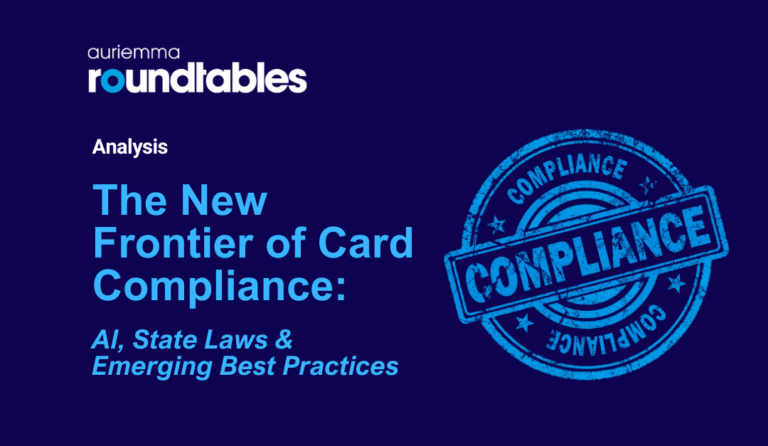October 20, 2025
How AI Is Redefining BSA/AML Programs
For years, banks’ AML teams have poured investment into detection systems—tuning rules, calibrating thresholds, and layering machine learning models to catch patterns of behavior within transaction flows.
But institutions are running into an operational ceiling, according to Auriemma Roundtables’ BSA/AML Roundtable members. What’s most hurting capacity? Narrative writing, not detection. While Roundtable members report stable alert volumes, suspicious activity report (SAR) production timelines are stretched thin by the amount of manual case documentation required. The next frontier will be reducing the investigative drag caused by manual narrative writing so analysts can spend their time on true risk judgment rather than documentation.
AI as a Complement to Human Effort, Not a Replacement
Today, many FIs take a linear approach to reporting suspicious activity: an alert is generated, an investigator assembles supporting transactions, a narrative is manually drafted, and a SAR is filed if criteria are met.
AI is not a replacement of the process but a reallocation of human effort. Instead of analysts spending 60–70% of their time constructing narratives, institutions can use AI tools to produce “first draft SARs.” These structured, regulator-aligned texts are based on case metadata and transaction flows and can act as templates that agents can adjust for each use case. These systems don’t decide whether a SAR is filed, but they drastically cut the average time between alert and submission.
“The BSA/AML teams who are testing this technology don’t see it as end-to-end automation, but rather as starting from 70% complete instead of 0%,” said Troy Huth, Senior Director of Auriemma’s BSA/AML Roundtable. “Analysts are still reviewing every word, but the effort shifts from writing to editing.”
This matters because investigator time is now the scarcest resource in AML operations. Staffing challenges have been repeatedly highlighted by Roundtable members, particularly as hybrid work models and in-office requirements strain retention. Many institutions are at a point where hiring cannot scale linearly with alert volume.
“If regulatory expectations keep rising and capacity stays flat, the only lever left is workflow reinvention,” said Huth. “Some large institutions have relied on bringing in consulting teams just to work through SAR backlogs, which can get expensive quickly.”
The AI use cases don’t stop at SAR drafting. Several institutions are piloting AI-driven SAR likelihood scoring, a predictive layer that sits upstream of narrative generation. Instead of treating every alert equally, AI models trained on past conversion patterns—a blend of typology type, transaction context, customer profile, and historical SAR outcomes—assign an estimated probability that a case will result in a SAR. Alerts with a high predicted SAR conversion rate are escalated earlier and given priority review, while lower-likelihood alerts are either queued differently or batched for lightweight screening.
“The goal isn’t to file more SARs,” said Huth. “It’s to file the right SARs faster and allocate resources on the cases that actually matter.”
Instead of analysts wading through queues of low-yield cases, AI narrows their field of focus to higher-risk, pattern-breaking activity—cases where human judgment, not machine pattern matching, adds true value.
AI’s Impact on Efficiency
These types of AI implementations can free human capacity for higher-order tasks.
Institutions experimenting with AI-assisted SARs writing report that investigators now have more bandwidth to work on emerging typologies and cross-channel behavioral analysis, such as:
- The growth of elder exploitation and imposter scams, which require narrative nuance and often intersect fraud and AML protocols.
- Increased gaming-related money movement, particularly through digital wallets, flagged as a rising concern by several Roundtable members.
- Cases involving personal accounts used for business activity, which fall into gray areas that require a human understanding of business models, not just transaction velocity.
Freed from repetitive documentation tasks, analysts’ roles transform from form processing to financial intelligence. They’re spending more time refining institution-specific typologies, challenging outdated monitoring logic, and proactively adjusting customer risk ratings based on behavioral shifts—functions that align more closely with regulatory expectations around “dynamic risk management” rather than static control frameworks.
Institutions are beginning to map where else AI can unlock investigator value. Some are exploring AI summarization for board reporting, transforming raw performance metrics—like SAR filing timeliness, aged inventory, and high-risk customer refresh cycles—into narrative executive dashboards. Others are using AI to identify typology drift, comparing the characteristics of current SARs against historical patterns to surface new behavioral clusters that may require separate risk scenarios. In high-performing programs, AI isn’t just a writing assistant—it’s a pattern recognition engine, flagging where the institution’s current lens on risk may be too narrow.
The narrative around AI in AML has often been dominated by fear—of regulatory misalignment, of model bias, of losing institutional knowledge. In practice, this means institutions deploying AI in SAR writing and risk prediction can also invest in AI literacy among investigators, enabling them to understand output quality, challenge assumptions, and articulate reasoning in examiner interactions. It also means rethinking traditional productivity metrics. “Instead of valuing analysts by volume, forward-looking programs value analytical impact per SAR,” Huth said. “Looking at investigator time spent on high-risk activity, typology refinement, and proactive risk scanning can be a better indicator of success.”
As Roundtable dialogue makes clear, AI can shift AML programs from a posture of compliance fulfillment to one of strategic risk intelligence. And in doing so, it may redefine the value of the AML investigator—not as a scribe of transactional history, but as a strategist shaping how financial crime risk is understood and acted upon.
Ready to go deeper? Join the conversation inside the BSA/AML Roundtable.
What emerges from Roundtable discussions is a new vision of AML operations: one where investigators are no longer case clerks but strategic analysts, where AI handles narrative assembly and predictive scoring, and where the real expertise lies in spotting what the model can’t see yet.
Auriemma Roundtables’ BSA/AML Roundtable brings together senior AML, compliance, and financial crime leaders from top institutions to compare real-world AI pilots—from SAR narrative automation and predictive scoring models to new workforce allocation strategies as manual case writing declines. Members openly share what regulators are asking, how they’re governing AI-assisted outputs, and how they’re reallocating investigator time toward typology intelligence and proactive risk scanning.
If you’re exploring AI for SAR drafting, rethinking alert queues, or trying to reclaim investigator capacity, this is where those conversations are already happening.
To learn more about membership or upcoming sessions, contact Zeenat Shah.



